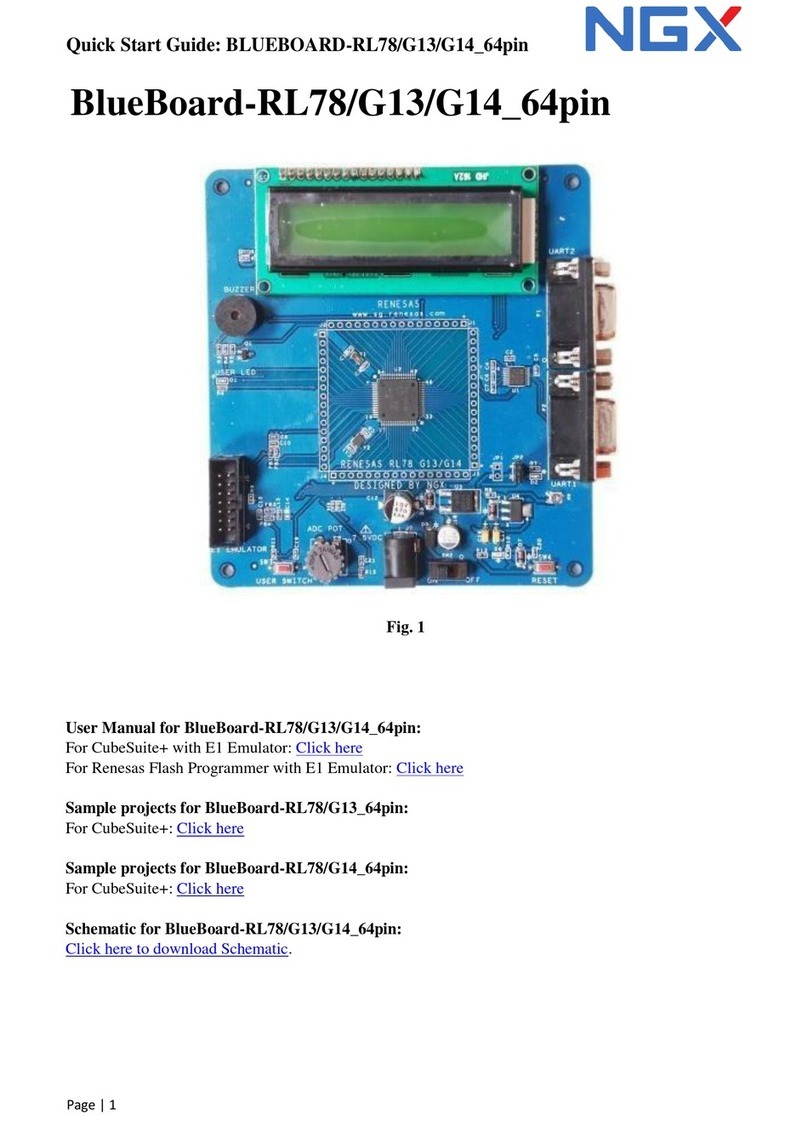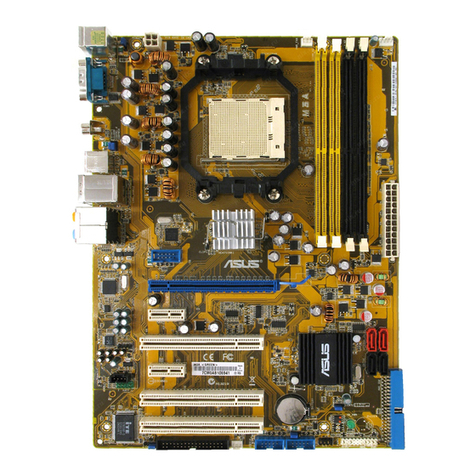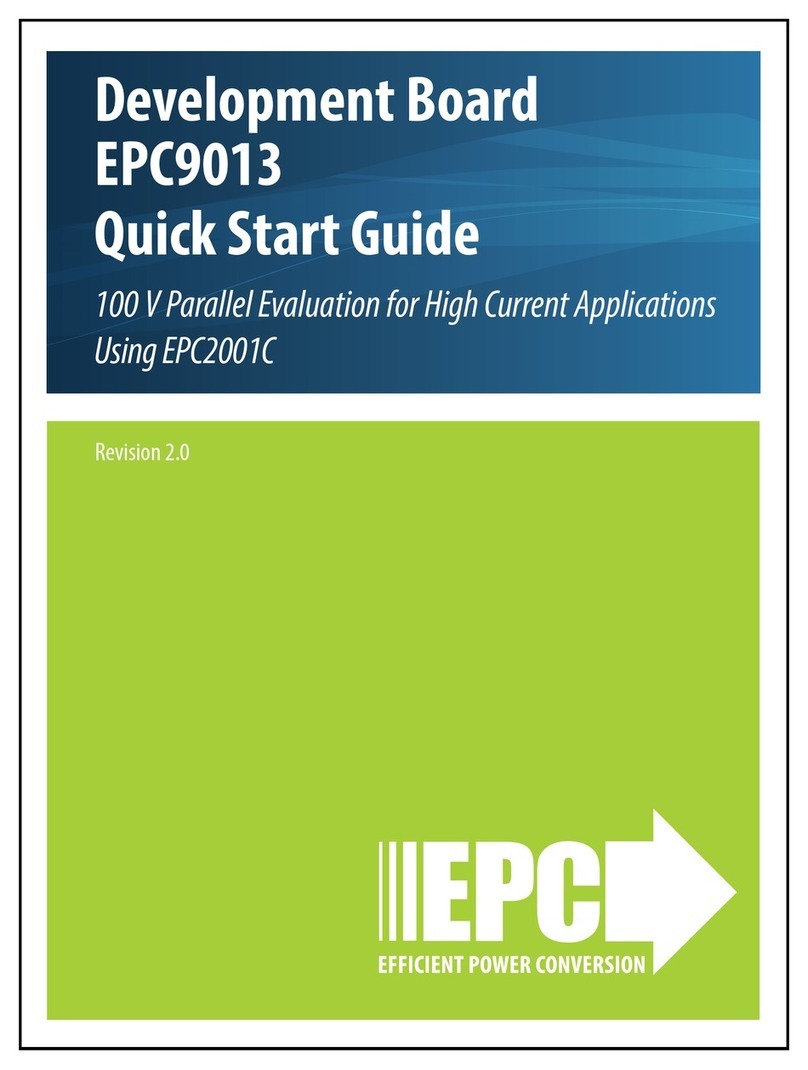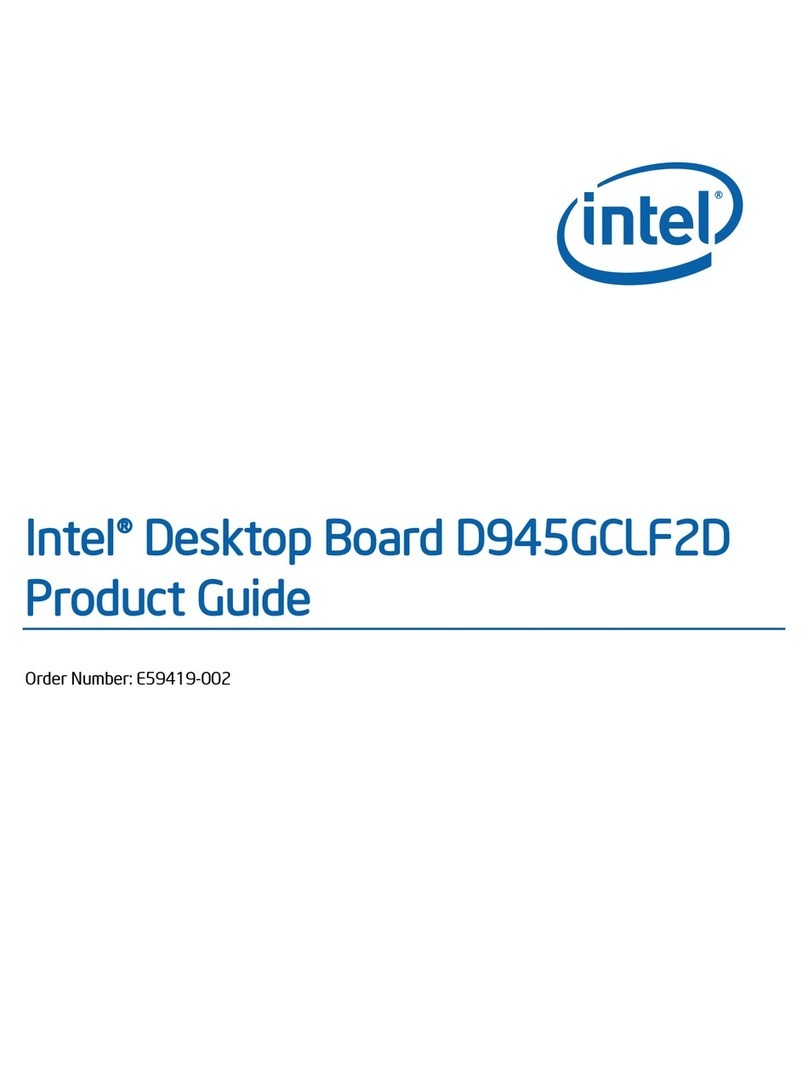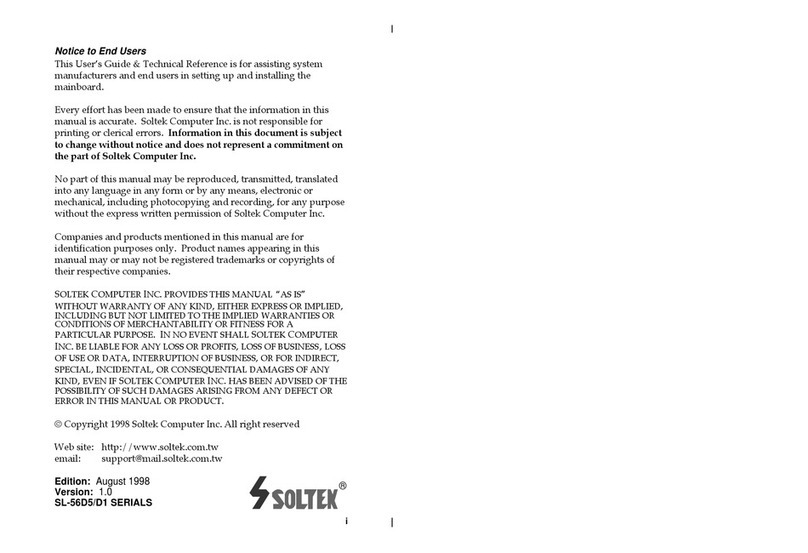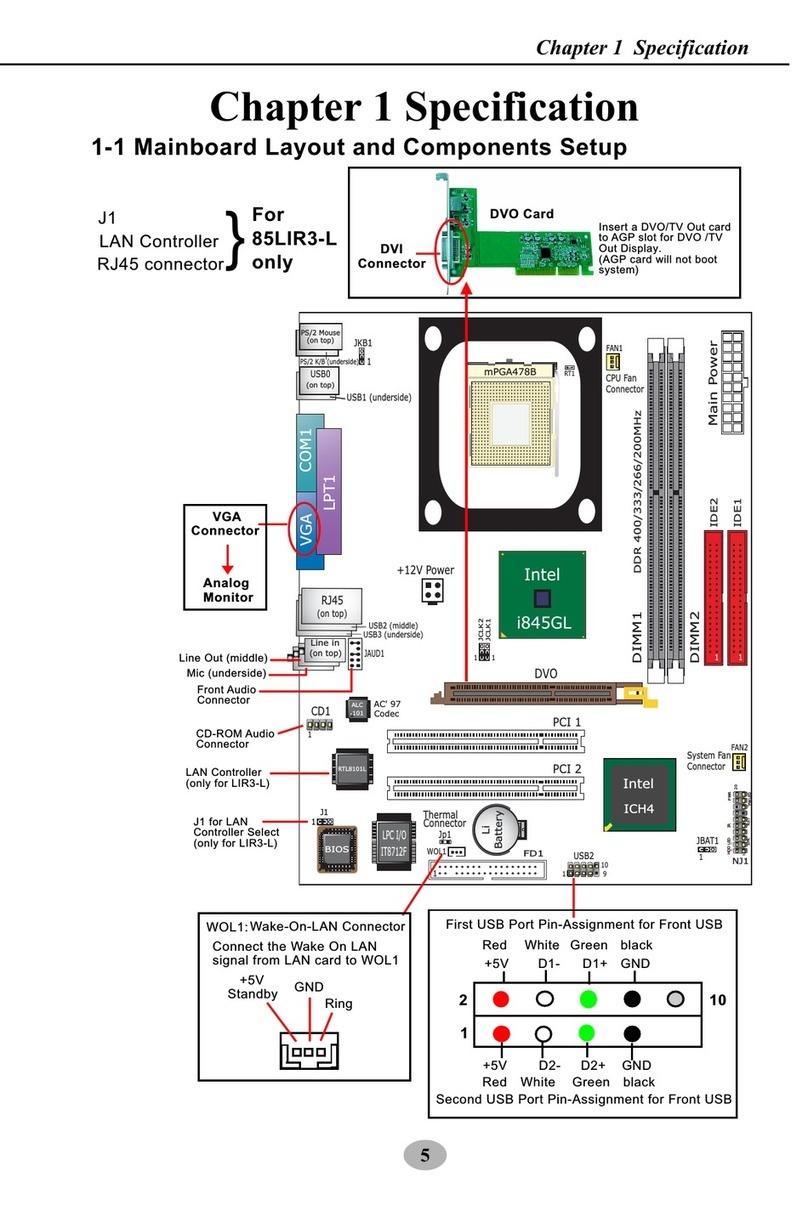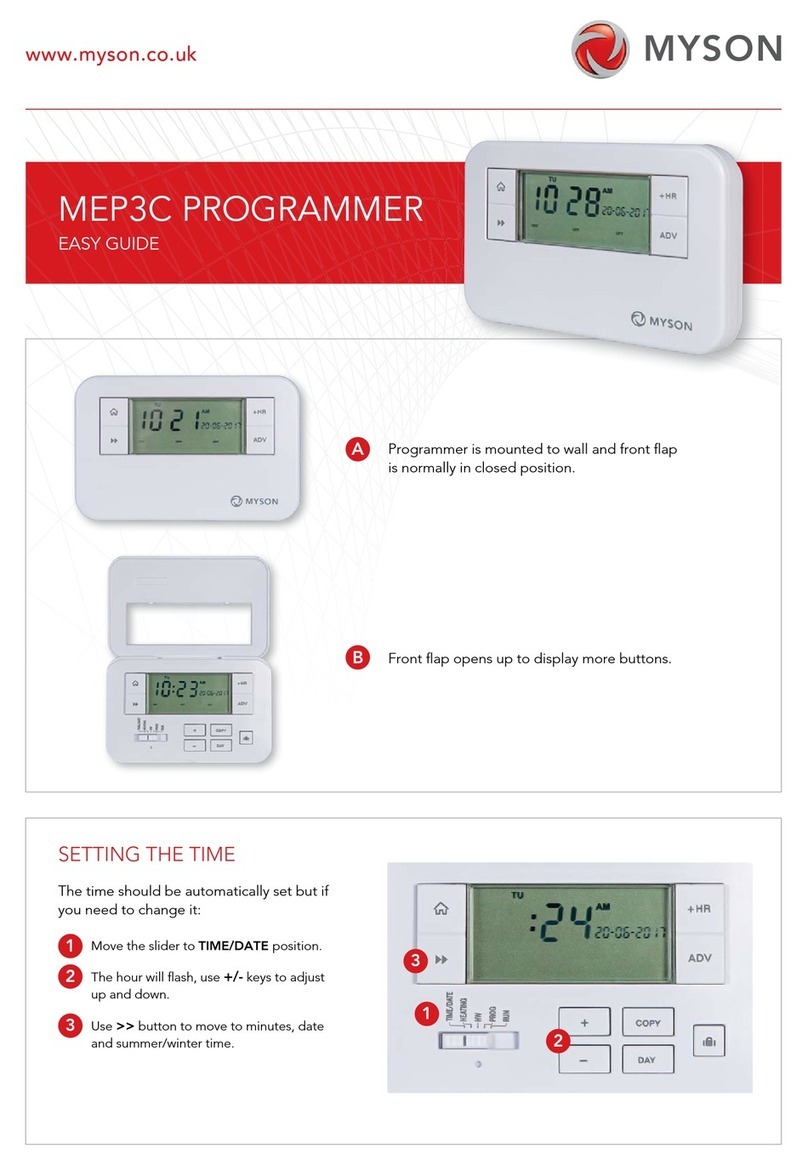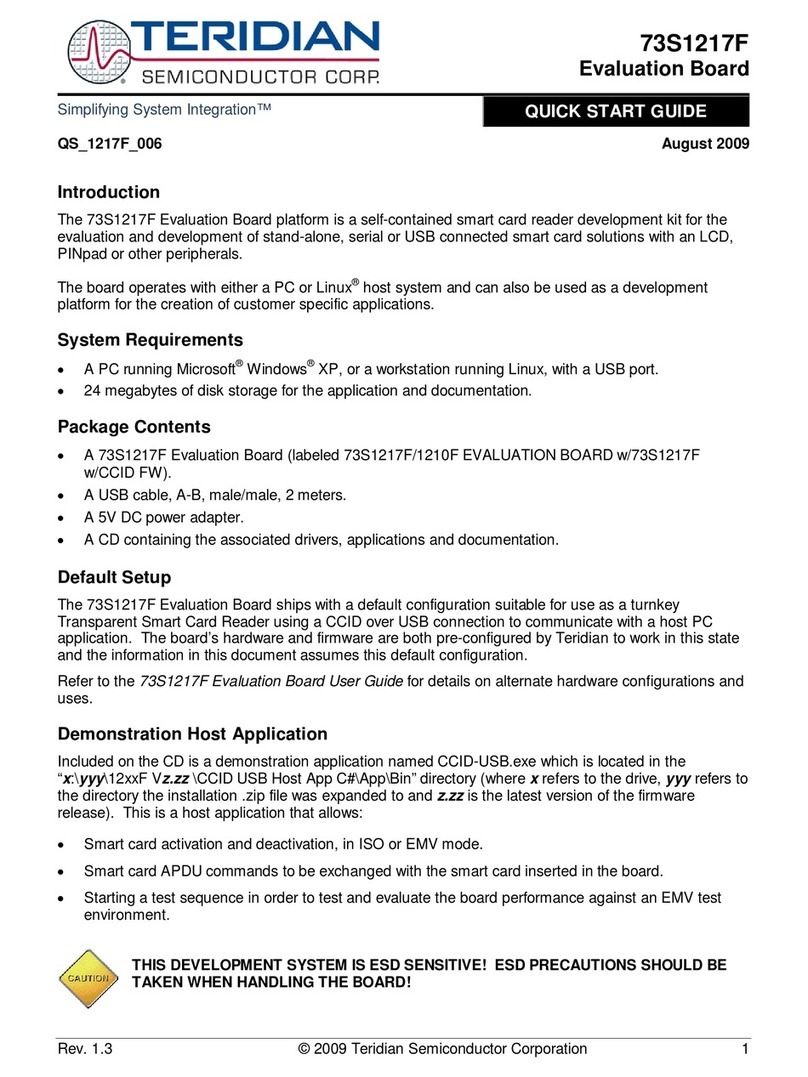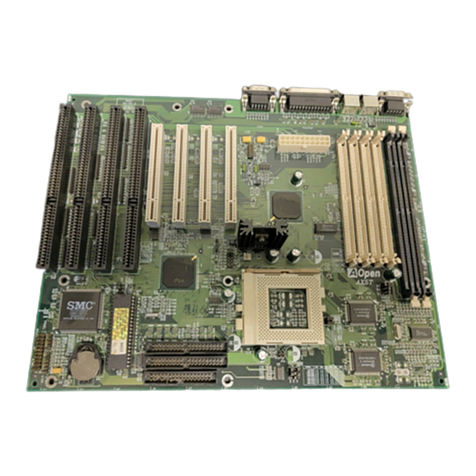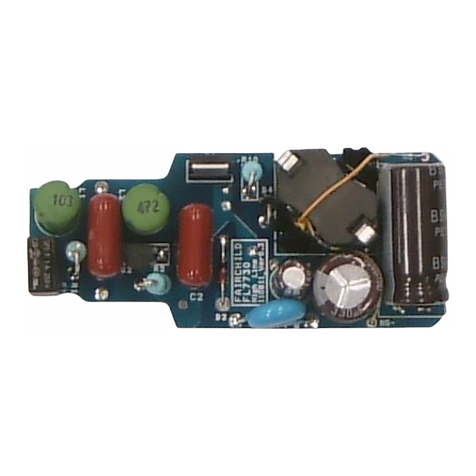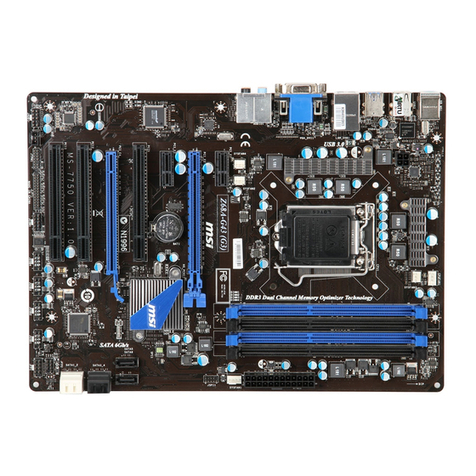NGX Technologies LPC435x-Xplorer++ User manual

Quick Start Guide: LPC435x-Xplorer++
1www.ngxtechnologies.com
LPC435x-Xplorer++
User Manuals for LPC435x-Xplorer++:
For KEIL MDK-ARM with ULINK2/ME: Click here
Sample projects for LPC435x-Xplorer++:
For KEIL MDK-ARM: Click here
USB Virtual Com INF file:
Click here to download USB Virtual Com INF file.

Quick Start Guide: LPC435x-Xplorer++
2www.ngxtechnologies.com
About NGX Technologies
NGX Technologies is a premier supplier of development tools for the ARM7, ARM Cortex M0, M3 and
M4 series of microcontrollers. NGX provides innovative and cost effective design solutions for
embedded systems. We specialize in ARM MCU portfolio, which includes ARM7, Cortex-M0, M3 &
M4 microcontrollers. Our experience with developing evaluation platforms for NXP controller enables
us to provide solutions with shortened development time thereby ensuring reduced time to market and
lower development costs for our customers. Our cost effective and feature rich development tool
offering, serves as a testimony for our expertise, cost effectiveness and quality.
Contact Information:
NGX Technologies Pvt. Ltd.
No.216, 5th main Road, R.P.C. Layout,
Vijayanagar 2nd Stage,
Bangalore –560 104
Phone : +91-80-40925507
email:[email protected]
CE certification:
NGX Technologies LPC435X-Xplorer++ board has been tested for radiated emission as per EN55022
class A standard. The device is under the limits of the standard EN55022 class A and hence CE marked.
No other test have been conducted other than the radiated emission (EN55022 class A standard). The
device was tested with the ports like USB, Serial, and Power excluding the GPIO ports. Any external
connection made to the GPIO ports may alter the EMC behavior. Usage of this device under domestic
environment may cause unwanted interference with other electronic equipment’s. User is expected to
take adequate measures. The device is not intended to be used in and end product or any subsystem
unless the user re-evaluates applicable directive/conformance.

Quick Start Guide: LPC435x-Xplorer++
3www.ngxtechnologies.com
Table of Contents
1.0 INTRODUCTION.................................................................................................................................4
1.1 Possible Debuggers and IDEs that can be used.................................................................................4
1.2 ARM JTAG (20-pin) to Cortex JTAG (10-pin) Adapter ..................................................................5
1.3 ULINK-ME and KEIL ......................................................................................................................6
1.4 ULINK2 and KEIL............................................................................................................................6
2.0 LPC435x-Xplorer++ Overview.............................................................................................................7
2.1 Introduction .......................................................................................................................................7
2.2 Board Features...................................................................................................................................7
2.3 BLOCK DIAGRAM .........................................................................................................................8
2.4 LPC435x-Xplorer++ pinout..............................................................................................................8
2.5 LPC435x description.........................................................................................................................9
3.0 LPC435x-Xplorer++ verification........................................................................................................12
3.1 Board Image with pointers to the peripherals .................................................................................12
3.2 Powering the Board.........................................................................................................................13
3.3 Verifying all the peripherals on LPC435x-Xplorer++....................................................................13
3.3.1 USB1 (Virtual COM port)............................................................................................................19
3.3.2 User Input Switch.........................................................................................................................21
3.3.3 Test LEDs.....................................................................................................................................22
3.3.4 Micro SD connector .....................................................................................................................22
3.3.5 SDRAM........................................................................................................................................23
3.3.6 RTC..............................................................................................................................................23
3.3.7 Ethernet ........................................................................................................................................24
3.3.8 Audio Interface.............................................................................................................................25
3.3.9 USB0_HOST................................................................................................................................26

Quick Start Guide: LPC435x-Xplorer++
4www.ngxtechnologies.com
1.0 INTRODUCTION
This document is a ‘Quick Start Guide’for LPC435x-Xplorer++; a cost effective evaluation platform for
NXP’s LPC435x MCU. This document focuses on the kit contents, board verification, possible
debuggers and IDEs that can be used.
1.1 Possible Debuggers and IDEs that can be used
ULINK2 with KEIL uVision
NXP LPCLink with LPCXpresso
Red Probe+ with Red Suite from Code Red
I-jet with IAR Embedded Workbench
Segger JLink with IAR Embedded Workbench or KEIL uVision
The LPC435x-Xplorer++ is packaged as shown in the following image.
TBD
Fig. 1

Quick Start Guide: LPC435x-Xplorer++
5www.ngxtechnologies.com
After unboxing the package you should find LPC435x-Xplorer++ Board, ‘USB AM to Micro B’cable
as shown in the following image.
Fig. 2
1.2 ARM JTAG (20-pin) to Cortex JTAG (10-pin) Adapter
Please note that your existing debugger might be supporting only the ‘20-pin ARM JTAG connector’. In
such scenarios one would require a ‘20-pin to 10-pin adaptor’and the necessary cables. The LPC435x-
Xplorer++ has on board ‘Cortex SWD/JTAG 10-pin male connector’, the ‘20-pin to 10-pin adaptor’is
not a part of the LPC435x-Xplorer++ package and user needs to buy them separately.
If the debugger supports the ‘10-pin Cortex header’one needs to have the 10-pin ribbon cable and can
directly connect to the LPC435x-Xplorer++. Please note even the 10-pin ribbon cable is not a part of
standard delivery and needs to be procured separately.
The picture below shows 20-pin ribbon cable, 10-pin ribbon cable and ‘20-pin to 10-pin adaptor’.
Fig. 3

Quick Start Guide: LPC435x-Xplorer++
6www.ngxtechnologies.com
1.3 ULINK-ME and KEIL
Connect one end of 10-pin ribbon cable ‘ULINK-ME 10-pin box header’and other end to LPC435x-
Xplorer++ as shown in the below image. The hardware setup is now ready for programing an LPC435x-
Xplorer++ board with ULINK-ME and KEIL IDE. Please refer keil knowledgebase article for
connecting ‘ULINK-ME 10-pin ribbon cable’to NGX Xplorer++.
Fig. 4
1.4 ULINK2 and KEIL
Connect ‘ULINK2 20-pin cable’to ‘20-pin to 10-pin adaptor’and connect one end of 10-pin ribbon
cable to ‘20-pin to 10-pin adaptor’and other end to LPC435x-Xplorer++ as shown in the below image.
The hardware setup is now ready for programing an LPC435x-Xplorer++ board with ULINK2 and
KEIL IDE. Please refer keil knowledgebase article for connecting ULINK2 to NGX Xplorer++.
Fig. 5

Quick Start Guide: LPC435x-Xplorer++
7www.ngxtechnologies.com
2.0 LPC435x-Xplorer++ Overview
2.1 Introduction
The NGX LPC435x-Xplorer++ is a compact and versatile evaluation platform for the NXP's Cortex-M4
based MCUs. NGX's evaluation platforms are generally not tied up to any particular debugger or
compiler/IDE. However it is not practical to test and ensure that the solution would work out of box
with all the available debuggers and compilers/IDE. As long as the compiler supports the particular
MCU and the debugger supports the standard debug interfaces like the SWD/JTAG you can use this
platform with any tool. The board is supported by extensive sample examples allowing you to focus on
the application development.
2.2 Board Features
Following are the salient features of the board
Dimensions: 102mm x 43mm
Controller: LPC435x, 256 pin BGA
PCB: 4-layer (RoHS complaint)
Two LEDs
One user switch and one reset switch
Boot select switch
32Mb Quad flash
32MB SDRAM
On board crystals for controller, RTC and audio codec
On board Ethernet PHY, 25 MHz Crystal and RJ45 connector with magnetics
On board audio codec and audio jacks
On board USB host port
On board RS232 level
On board USB port
10-pin cortex debug header
Unused I/Os brought to a header.

Quick Start Guide: LPC435x-Xplorer++
8www.ngxtechnologies.com
2.3 BLOCK DIAGRAM
Fig. 6
2.4 LPC435x-Xplorer++ pinout
Fig.7

Quick Start Guide: LPC435x-Xplorer++
9www.ngxtechnologies.com
2.5 LPC435x description
The LPC435x is ARM Cortex-M4 based microcontroller for embedded applications which include an
ARM Cortex-M0 coprocessor, up to 1 MB of flash and 136 kB of on-chip SRAM, 16 kB of EEPROM
memory, a quad SPI Flash Interface (SPIFI), advanced configurable peripherals such as the State
Configurable Timer (SCT) and the Serial General Purpose I/O (SGPIO) interface, two High-speed USB
controllers, Ethernet, LCD, an external memory controller, and multiple digital and analog peripherals.
The LPC435x operate at CPU frequencies of up to 204 MHz.
Cortex-M4 Processor core
ARM Cortex-M4 processor, running at frequencies of up to 204 MHz.
ARM Cortex-M4 built-in Memory Protection Unit (MPU) supporting eight regions.
ARM Cortex-M4 built-in Nested Vectored Interrupt Controller (NVIC).
Hardware floating-point unit.
Non-maskable Interrupt (NMI) input.
JTAG and Serial Wire Debug (SWD), serial trace, eight breakpoints, and four watch points.
Enhanced Trace Module (ETM) and Enhanced Trace Buffer (ETB) support.
System tick timer.
Cortex-M0 Processor core
ARM Cortex-M0 co-processor capable of off-loading the main ARM Cortex-M4 application
processor.
Running at frequencies of up to 204 MHz.
JTAG
Built-in NVIC.
On-chip memory
Up to 1 MB on-chip dual bank flash memory with flash accelerator.
16 kB on-chip EEPROM data memory.
136 kB SRAM for code and data use.
Multiple SRAM blocks with separate bus access. Two SRAM blocks can be powered down
individually.
64 kB ROM containing boot code and on-chip software drivers.
64 bit of general-purpose One-Time Programmable (OTP) memory.
Configurable digital peripherals
Serial GPIO (SGPIO) interface.
State Configurable Timer (SCT) subsystem on AHB.
Global Input Multiplexer Array (GIMA) allows to cross-connect multiple inputs and outputs to
event driven peripherals like the timers, SCT, and ADC0/1.
Serial interfaces
Quad SPI Flash Interface (SPIFI) with four lanes and up to 52 MB per second.
10/100T Ethernet MAC with RMII and MII interfaces and DMA support for high throughput at
low CPU load. Support for IEEE 1588 time stamping/advanced time stamping (IEEE 1588-2008
v2).
One High-speed USB 2.0 Host/Device/OTG interface with DMA support and on-chip high-
speed PHY. One High-speed USB 2.0 Host/Device interface with DMA support, on-chip full-
speed PHY and ULPI interface to external high-speed PHY.
USB interface electrical test software included in ROM USB stack.
One 550 UART with DMA support and full modem interface.
Three 550 USARTs with DMA and synchronous mode support and a smart card interface
conforming to ISO7816 specification. One USART with IrDA interface.

Quick Start Guide: LPC435x-Xplorer++
10 www.ngxtechnologies.com
Up to two C_CAN 2.0B controllers with one channel each. Use of C_CAN controller excludes
operation of all other peripherals connected to the same bus bridge
Two SSP controllers with FIFO and multi-protocol support. Both SSPs with DMA support.
One SPI controller.
One Fast-mode Plus I2C-bus interface with monitor mode and with open-drain I/Opins
conforming to the full I2C-bus specification. Supports data rates of up to 1Mbit/s.
One standard I2C-bus interface with monitor mode and with standard I/O pins.
Two I2S interfaces, each with DMA support and with one input and one output.
Digital peripherals
External Memory Controller (EMC) supporting external SRAM, ROM, NOR flash, and SDRAM
devices.
LCD controller with DMA support and a programmable display resolution of up to1024 H
x768V. Supports monochrome and color STN panels and TFT color panels; supports 1/2/4/8 bpp
Color Look-Up Table (CLUT) and 16/24-bit direct pixel mapping. Available on parts
LPC4357/53 only.
Secure Digital Input Output (SD/MMC) card interface.
Eight-channel General-Purpose DMA controller can access all memories on the AHB and all
DMA-capable AHB slaves.
Up to 164 General-Purpose Input/Output (GPIO) pins with configurable pull-up/pull-down
resistors.
GPIO registers are located on the AHB for fast access. GPIO ports have DMA support.
Up to eight GPIO pins can be selected from all GPIO pins as edge and level sensitive interrupt
sources.
Two GPIO group interrupt modules enable an interrupt based on a programmable pattern of
input states of a group of GPIO pins.
Four general-purpose timer/counters with capture and match capabilities.
One motor control Pulse Width Modulator (PWM) for three-phase motor control.
One Quadrature Encoder Interface (QEI).
Repetitive Interrupt timer (RI timer).
Windowed watchdog timer (WWDT).
Ultra-low power Real-Time Clock (RTC) on separate power domain with 256 bytes of battery
powered backup registers.
Alarm timer; can be battery powered.
Analog peripherals
One 10-bit DAC with DMA support and a data conversion rate of 400 kSamples/s.
Two 10-bit ADCs with DMA support and a data conversion rate of 400 kSamples/s. Up to eight
input channels per ADC.
Unique ID for each device.
Clock generation unit
Crystal oscillator with an operating range of 1 MHz to 25 MHz.
12 MHz internal RC oscillator trimmed to 2 % accuracy over temperature and = voltage (1 %
accuracy for Tamb = 0 °C to 85 °C).
Ultra-low power Real-Time Clock (RTC) crystal oscillator.
Three PLLs allow CPU operation up to the maximum CPU rate without the need for a high-
frequency crystal. The second PLL can be used with the High-speed USB, the third PLL can be
used as audio PLL.
Clock output.

Quick Start Guide: LPC435x-Xplorer++
11 www.ngxtechnologies.com
Power
Single 3.3 V (2.2 V to 3.6 V) power supply with on-chip DC-to-DC converter for the core supply
and the RTC power domain.
RTC power domain can be powered separately by a 3 V battery supply.
Four reduced power modes: Sleep, Deep-sleep, Power-down, and Deep power-down.
Processor wake-up from Sleep mode via wake-up interrupts from various peripherals.
Wake-up from Deep-sleep, Power-down, and Deep power-down modes via external interrupts
and interrupts generated by battery powered blocks in the RTC power domain.
Brownout detect with four separate thresholds for interrupt and forced reset.
Power-On Reset (POR).
For the most updated information on the MCU please refer to NXP's website.

Quick Start Guide: LPC435x-Xplorer++
12 www.ngxtechnologies.com
3.0 LPC435x-Xplorer++ verification
NGX's evaluation platforms ship with a factory-programmed test firmware that verifies all the on-board
peripherals. It is highly recommended that you verify the board, before you start programming. Also this
exercise helps you get acclimatized with the board quickly.
To run the tests you will need the following:
LPC435x-Xplorer++
Power: USB cable or external power supply (Alternatively the LPC435x-Xplorer++ has a 5V in
pin available for powering through external power source)
PC: With Windows7 or XP (32-bit or 64-bit)
One USB AM to Micro B cable
Micro SD card
2-GB USB pen drive
Audio-out (Auxiliary) cable (3.5mm diameter connector)
3.1 Board Image with pointers to the peripherals
Fig.8

Quick Start Guide: LPC435x-Xplorer++
13 www.ngxtechnologies.com
3.2 Powering the Board
The LPC435x-Xplorer++ can be powered through USB1, It is highly recommended that the user tests all
the peripherals as soon as the board is received. A regulated supply can be supplied to the 5V pin on the
LPC435x-Xplorer++ header.
Note: The USB power can source only up to 500 mA of current. For applications having higher current
requirements we recommend to use an external power supply. Please note that the external power
supply is not a part of standard delivery.
3.3 Verifying all the peripherals on LPC435x-Xplorer++
The following section focuses on the verification of all the peripherals supported on theLPC435x-
Xplorer++. The order of the tests is mentioned in the same manner as the flow of the test firmware. We
highly recommend that you follow the order of the test. The test firmware is designed in a manner that
the user needs to spend as minimum time as possible to verify all the on-board peripherals. The test
firmware executable resides on the Quad Flash. The BOOT select switch is configured to execute from
the Quad Flash interface.
Note: The test firmware “Debug Messages” or flow might be changed in due course. Generally these
are only cosmetic changes so that the usage is easier. If you observe a different message than the one
mentioned in the Manual, do not worry and please proceed with the test.
Important Note: The user needs to press the RESET switch to be able to reset the controller. However
for the power up reset (USB power cycle) the controller boots up fine.
Power up the board over USB1 port and we are all set to verify the LPC435x-Xplorer++ peripherals.
Before we get to the verification we need to install the Virtual COM port drivers needed for the
LPC435x-Xplorer++ (USB1 port) to appear as a Virtual COM port (Used for viewing the debug
messages on serial emulation tool). Fortunately, this is a one-time setup and fairly simple. On a
Windows machine the user needs to point to the location of the INF file. Download INF file Click Here

Quick Start Guide: LPC435x-Xplorer++
14 www.ngxtechnologies.com
Steps to install the VCOM drivers on windows 7 machine:
Step 1: Connect USB1 to the computer, Open device manager, you can find “NXP LPC43xx VCOM”
new device listed under ‘Other devices’.
Fig.9
Step 2: Right click on the “NXP LPC43xx VCOM”and then left click on ‘Update Driver Software’.
Fig.10

Quick Start Guide: LPC435x-Xplorer++
15 www.ngxtechnologies.com
Step 3: Click on Browse my computer for driver software.
Fig.11
Step 4: Click Browse, select downloaded LPC4350-Xplorer++_Rev AR2_Keil\Usb1VcomLib folder
and then click on OK.
Fig.12

Quick Start Guide: LPC435x-Xplorer++
16 www.ngxtechnologies.com
Step 5: Click on Next to continue driver installation.
Fig.13
Step 6: Click on ‘Install this driver software anyway’.
Fig.14

Quick Start Guide: LPC435x-Xplorer++
17 www.ngxtechnologies.com
Step 7: The ‘LPC43xx USB VCom driver’is successfully installed, click on close.
Fig.15
Step 8: Now ‘LPC43xx USB VCom Port’(COM12) is ready to use.
Fig.16
Note: The Virtual COM is listed under the device manager. Please note that the COM port list under the
Device Manager is automatically updated with the COM port number for the Virtual COM. On our test
machine COM12 is the virtual COM port. The COM12 will appear only if the Xplorer++ board is
connected (USB1) to the PC. Every time the Xplorer++ is reset the user needs to close the Hyper
Terminal application and restart it again.

Quick Start Guide: LPC435x-Xplorer++
18 www.ngxtechnologies.com
The orders in which the on-board peripherals are verified by the firmware are as follows:
Test Firmware Flowchart:
NO
YES
NO
YES
START
Is VCOM
Enumeration
Completed?
A
Ethernet PHY
Verification
Xplorer++
Peripherals
Initialization
Wait for user input
Flag == 1?
LEDs Blink
(LED4 and LED5)
SD card
Verification
SDRAM
Verification
A
RTC Verification
Audio codec
Verification

Quick Start Guide: LPC435x-Xplorer++
19 www.ngxtechnologies.com
3.3.1 USB1 (Virtual COM port)
Test setup and verification:
For the very first time the windows machine will ask for the appropriate virtual COM drivers to be
installed.
Steps to select ‘USB1 VCOM port’on HyperTerminal in windows 7 machine:
Step 1: Open a HyperTerminal, type name and click on OK.
Fig.17
Step 2: Select ‘USB1 Vcom Port’(COM12) and click on OK.
Fig.18

Quick Start Guide: LPC435x-Xplorer++
20 www.ngxtechnologies.com
Step 3: Click on ‘Restore Defaults’and click on OK.
Fig.19
Step 4: Now the ‘USB1 VCom’is ready to use.
Fig.20
Note: You would not be able to proceed with the verification unless the Virtual COM drivers are
installed. The firmware waits for the USB1 to enumerate as VCOM port.
Other manuals for LPC435x-Xplorer++
1
Table of contents
Other NGX Technologies Motherboard manuals
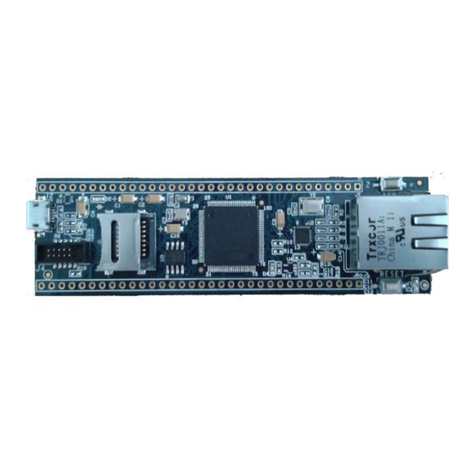
NGX Technologies
NGX Technologies LPC1768-Xplorer User manual
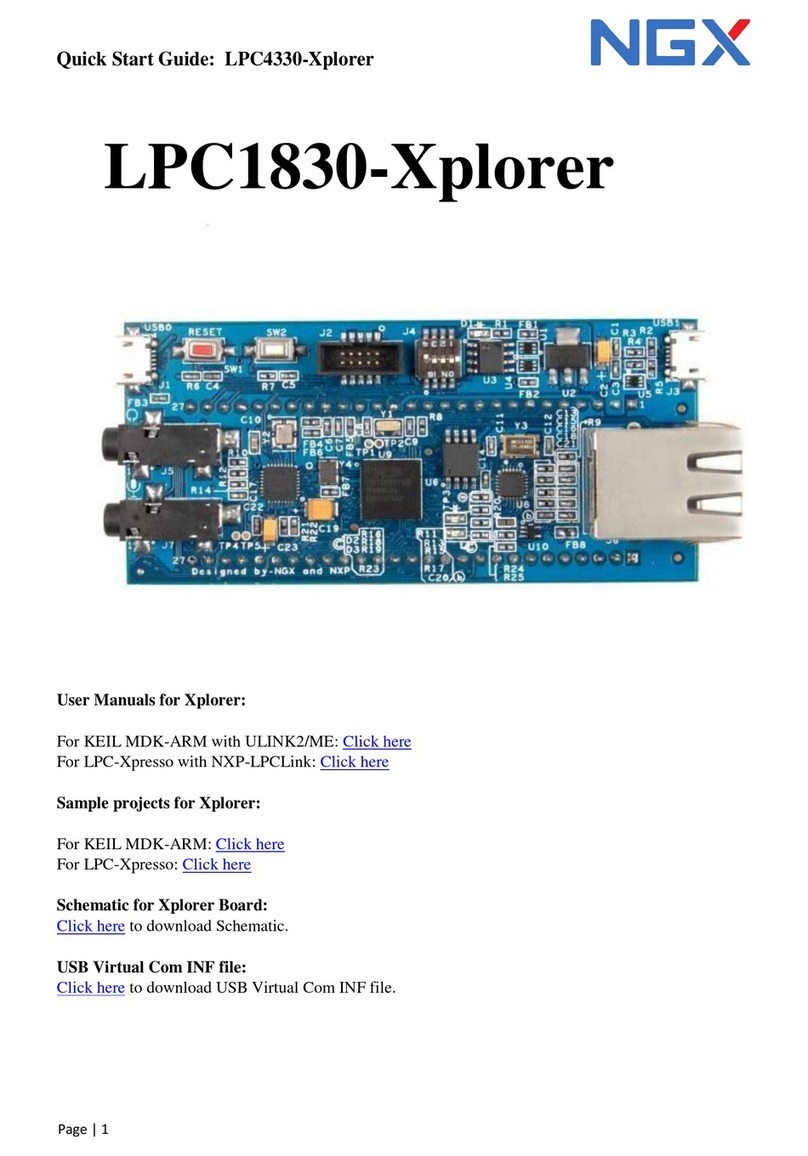
NGX Technologies
NGX Technologies LPC1830-Xplorer User manual
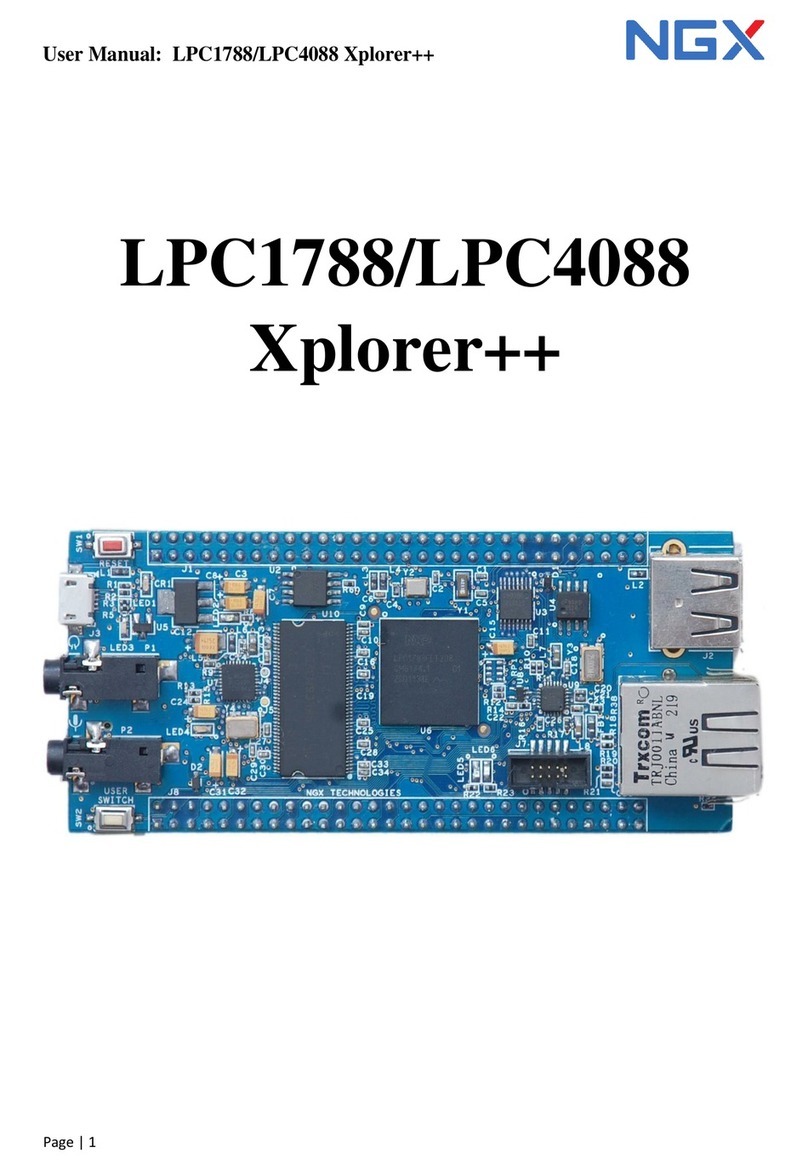
NGX Technologies
NGX Technologies LPC1788 Xplorer++ User manual
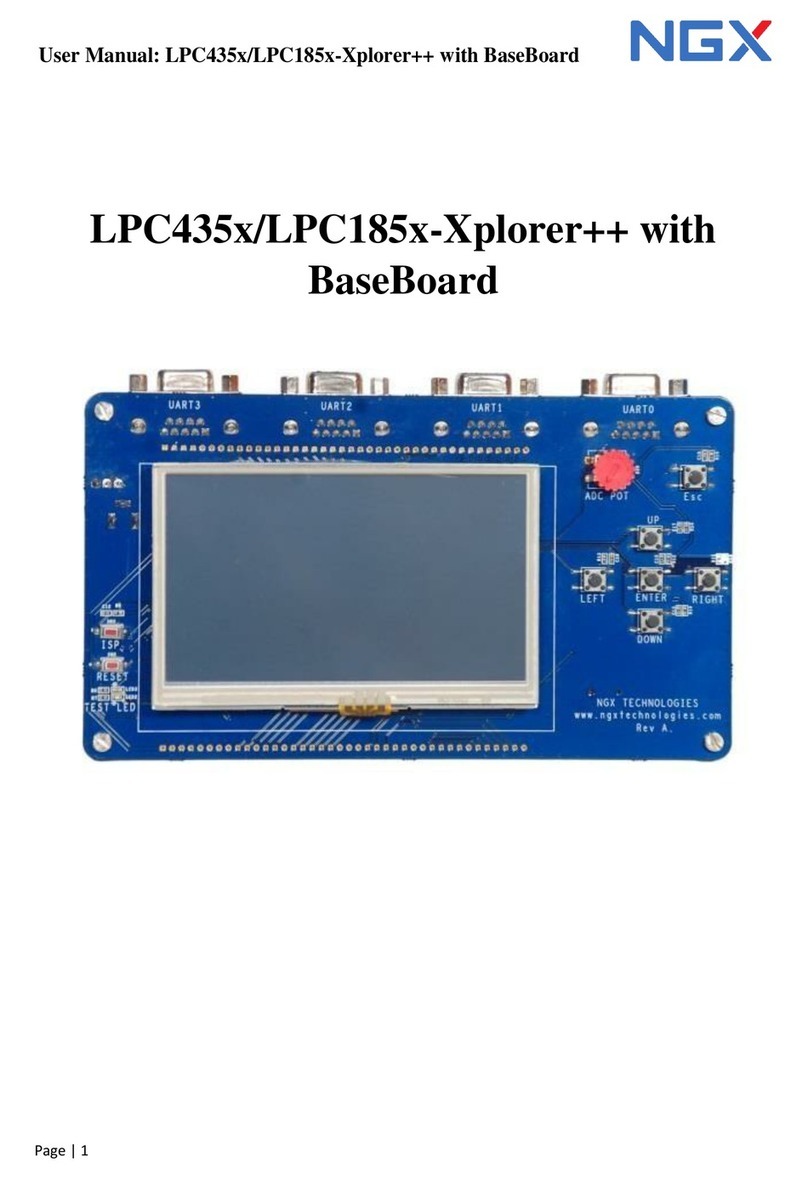
NGX Technologies
NGX Technologies LPC435x User manual
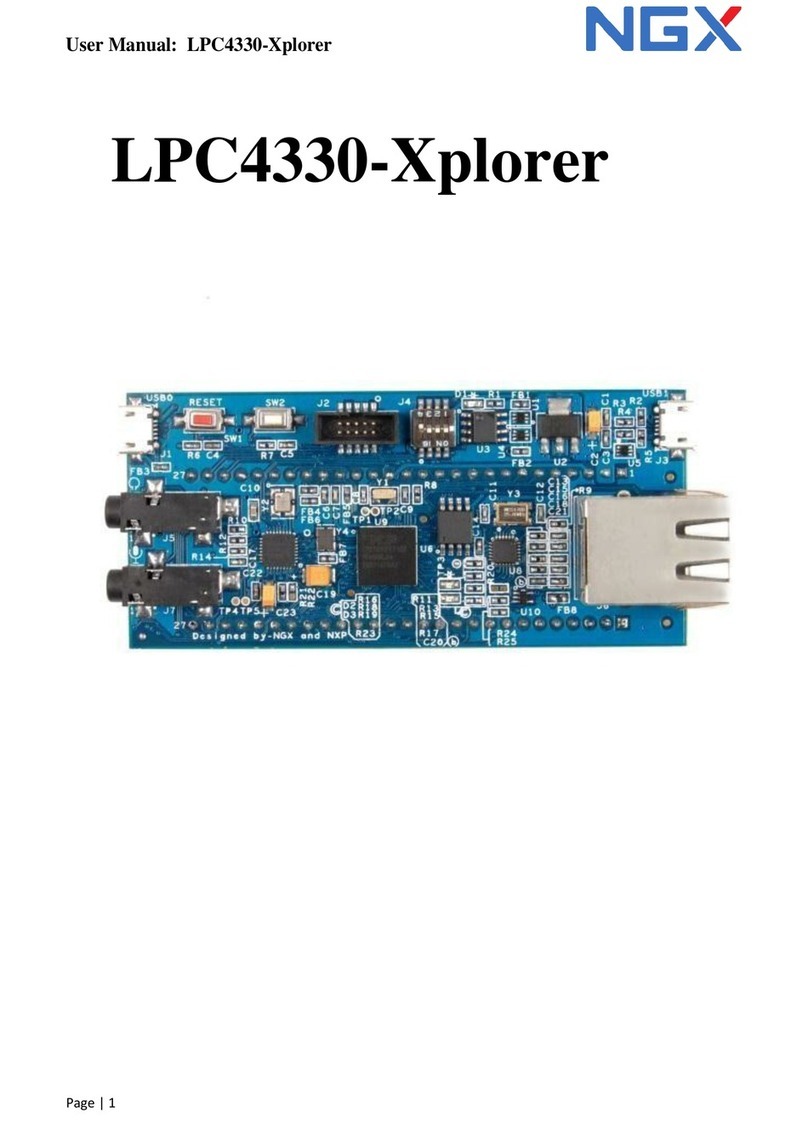
NGX Technologies
NGX Technologies LPC4330-Xplorer User manual
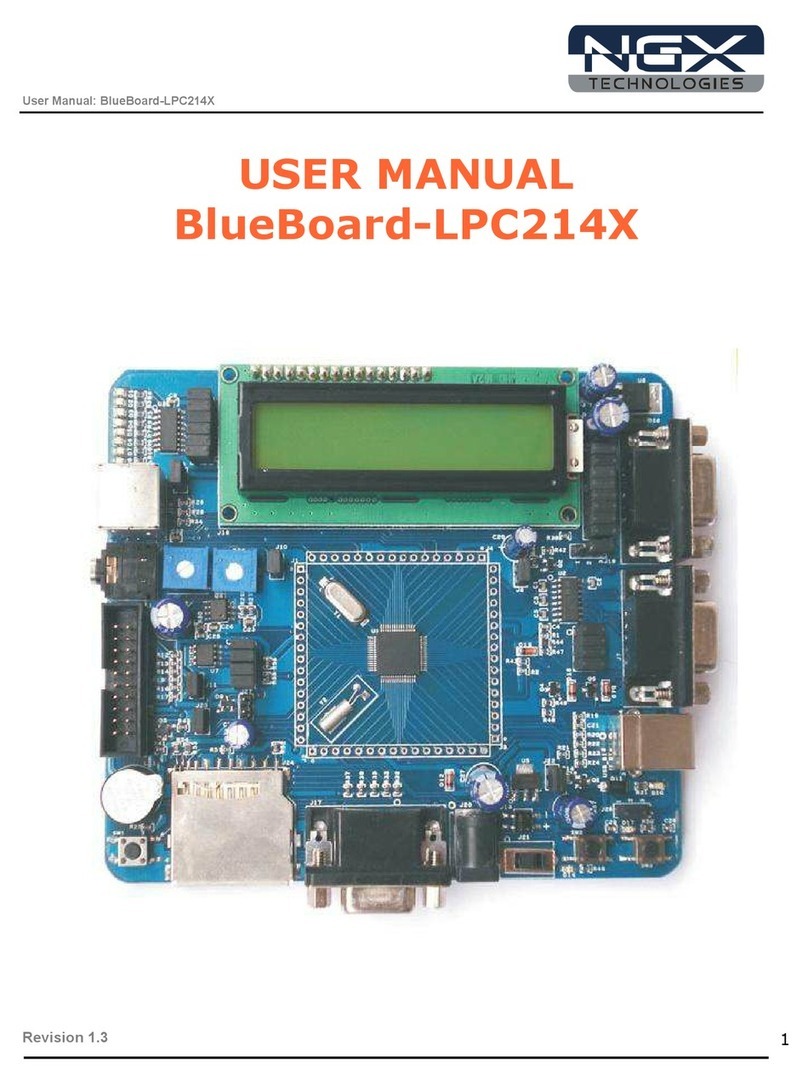
NGX Technologies
NGX Technologies BlueBoard-LPC214X User manual

NGX Technologies
NGX Technologies BlueBoard Base User manual
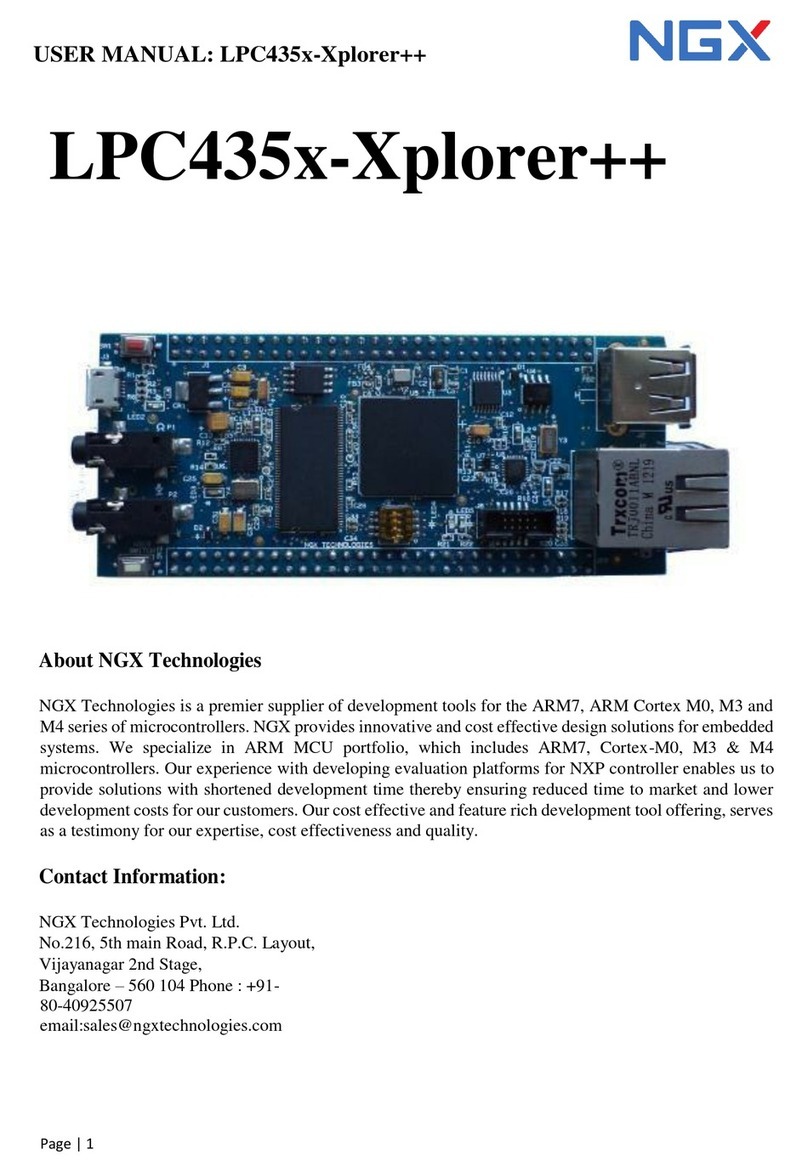
NGX Technologies
NGX Technologies LPC435x-Xplorer++ User manual
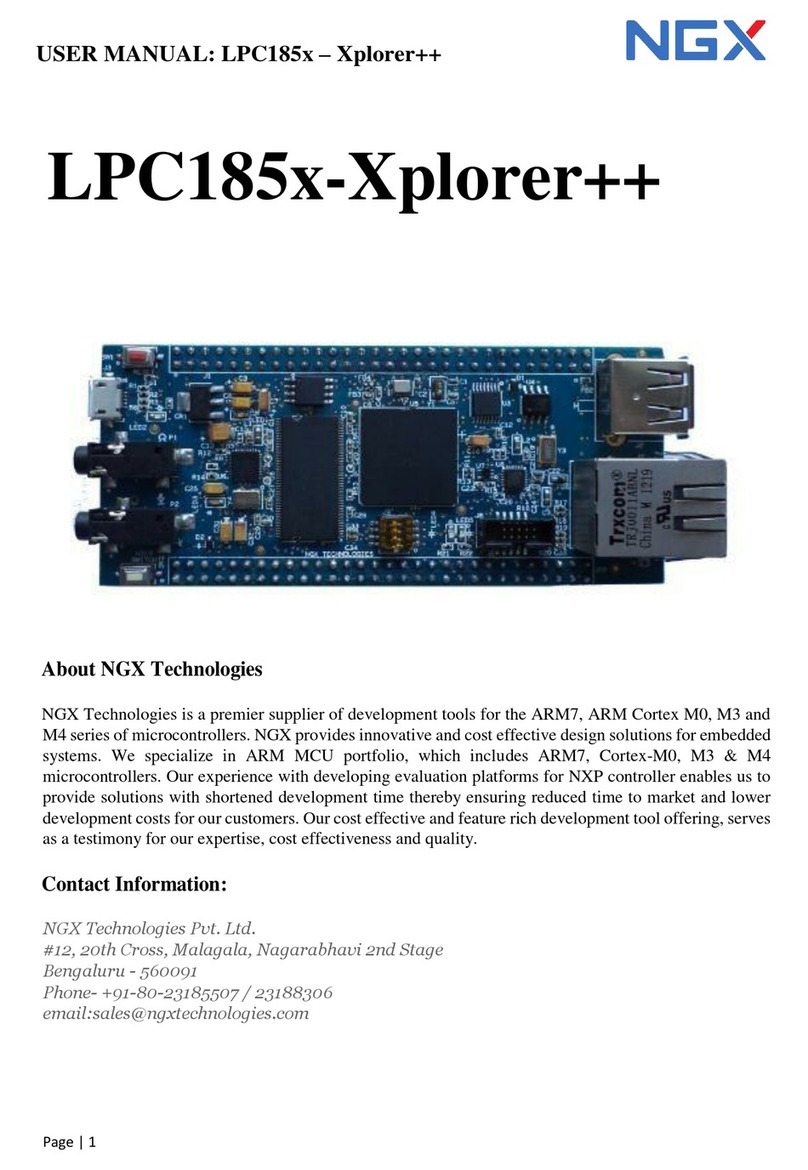
NGX Technologies
NGX Technologies LPC185X-Xplorer++ User manual
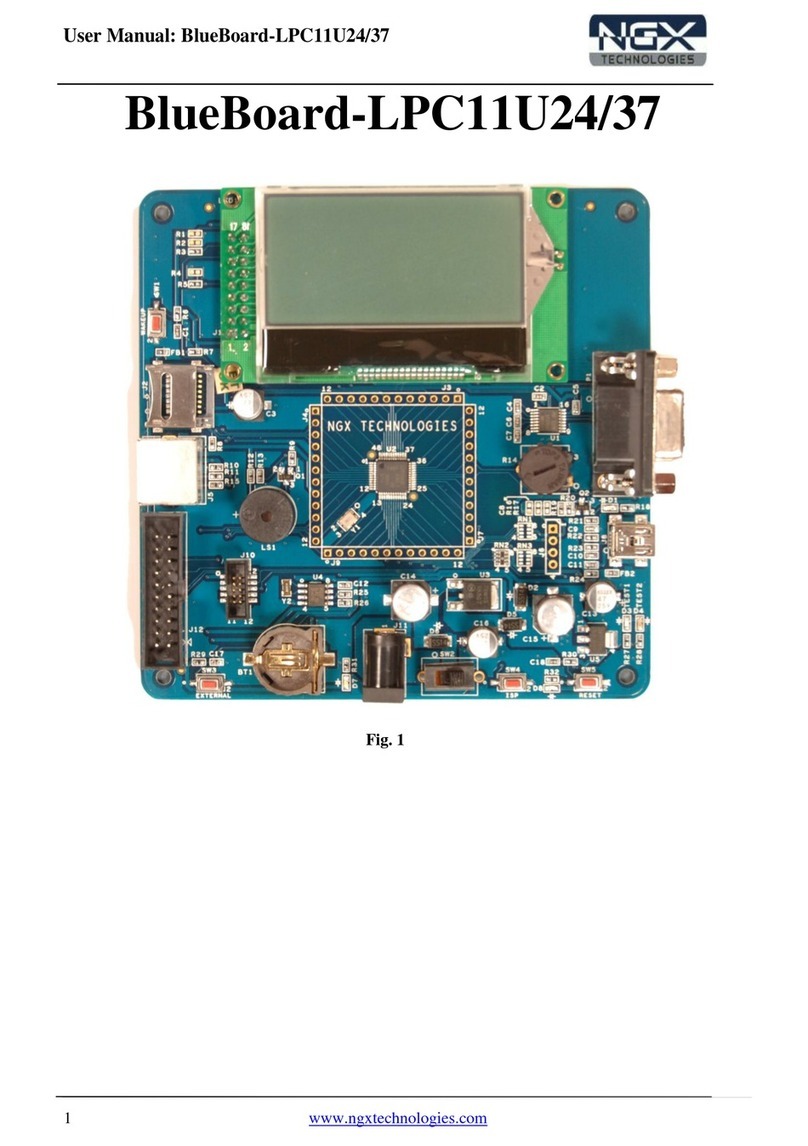
NGX Technologies
NGX Technologies BlueBoard-LPC11U24/37 User manual
